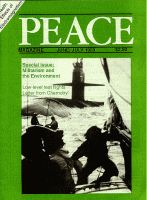
Peace Magazine Jun-Jul 1989, page 14. Some rights reserved.
Search for other articles by Patti Willis here
In glossy promotionals, British Columbia extolls itself as "Super Natural B.C." However, just above its towering Douglas firs, B.C. may soon fly some not-so-super natural planes.
In 1985 the U.S. Strategic Air Command (SAC) and the North American Aerospace Defense Command (NORAD) proposed to establish a low-level military training corridor in British Columbia. The proposed 1387 km route begins in northeastern B.C., skims over pristine natural habitat and 17 native reserves, and ends near Comox. Initially, flight training would consist of four one-day exercises (one in each season) with such evocative names as "Snowtime" and "Global Shield"; 15-30 aircraft would fly as low as 350 feet above the ground. Aircraft include the US. nuclear cruise missilecapable B-52 and B-1B bombers, U.S. F-111s and F-15s, and Canadian F-18s.
A New York Times article reported that SAC's nuclear war plans call for almost two hundred B-52 bombers to carry nuclear cruise missiles for launching several hundred miles from Soviet radar and missile sites. Destruction of these targets prepares the way for B-1 bombers' low altitude penetration into the Soviet Union.
Canada, after testing cruise missiles, will accommodate the training of pilots to deliver them. The routes may also be used with U.S. naval military exercises. Though the Canadian government claims to be unaware of the plans, last summer a U.S. Vice Admiral announced that in 1990 the U.S. Navy will begin training its six West Coast-based aircraft carriers off the coast of B.C. The plan reportedly includes joint operations with Canadian forces and the low-level training routes in B.C.
The environmental price tag for these flights could be large. Among wildlife populations that will have war games played over their heads are mountain sheep, woodland caribou, wolves, moose, mountain goats, and elk. Over a million ducks, geese, and swans migrate across the flight route twice a year. The route passes over nesting areas of golden and bald eagles. Along most of the flight route are ecological reserves, provincial parks, agricultural areas, and trapping areas.
An Initial Environmental Evaluation of the route, conducted for SAC and DND by a private consultant, was completed in December, 1987. It is a weak and inadequate document that relied on outdated information about wildlife populations. Noise data for military aircraft was provided by the U.S. Air Force, the very agency to benefit by approval of the route.
The evaluation acknowledges that these flights could result in the abandonment of habitats, changes in the distribution of wildlife, and decreased reproductive success, since the flights would overlap with critical periods in the life cycles of some birds and animals. However, the study never deals with the ecosystem as a whole.
Moreover, it restricts itself to considering "routine" aircraft operating procedures, not the environmental consequences of "abnormal" operating activities. This could be a dangerous oversight, since the B-52 bomber averages one crash a year and B-1 bombers have crashed four times in the past five years. The Pentagon said of one accident that the aircraft reported, in a language appropriate to warfare, that it had experienced "multiple bird strikes" prior to its crash. In fact, pelicans had been sucked into the engines.
The evaluation does propose measures to mitigate potential effects. However, it failed to consider postponing the exercises until full environmental data exist. Evidently, it considered only factors acceptable to SAC.
The B.C. low-level flight training route has not yet been given approval by the new Minister for National Defence, Bill McKnight. However, the B.C. Ministry of Environment Wildlife Branch's said that it has "no concerns about the route." (Not even one?) That cavalier remark, combined with the meagre environmental evaluation, cannot inspire confidence that B.C.'s rich but fragile environment will be spared from nuclear war preparations.
Patti Willis (Denman Island, B.C.) is Resource Coordinator for the Pacific Campaign to Disarm the Seas.

Peace Magazine Jun-Jul 1989, page 14. Some rights reserved.
Search for other articles by Patti Willis here